
Espostoa melanostele subsp. nana-Peruvian Old Lady on 7-19-16, #274-32.
Peruvian Old Lady
Espostoa melanostele subsp. nana
es-POS-toh-uh ? NAN-uh
Synonyms of Espostoa melanostele (5) (Updated 12-7-23 from Plants of the World Online): Binghamia melanostele (Vaupel) Britton & Rose (1920), Cephalocereus melanostele Vaupel (1913), Cereus melanostele (Vaupel) A.Berger (1929), Echinopsis melanostele (Vaupel) Molinari (2015), Pseudoespostoa melanostele (Vaupel) Backeb. (1933)
Synonyms of Espostoa melanostele subsp. melanostele (4) (Updated on 12-7-23 from POWO): Espostoa haagei (Poselg. ex C.F.Först. & Rümpler) Borg (1937), Espostoa melanostele f. inermis (Backeb.) Krainz (1964), Pilocereus haagei Poselg. ex C.F.Först. & Rümpler (1885), Pseudoespostoa melanostele var. inermis Backeb. (1951)
Synonyms of Espostoa melanostele subsp. nana (2) (Updated on 12-7-23 from POWO: Espostoa nana F.Ritter (1964), Pseudoespostoa nana (F.Ritter) Backeb. (1966)
Espostoa melanostele (Vaupel) Borg, was named and described by John Borg in Cacti in 1937. It was first named Cephalocereus melanostele Vaupel and described by Friedrich Karl Johann Vaupel in Botanische Jahrbuecher fuer Systematik in 1913.
Accepted Infraspecific Names (2) (Updated on 12-7-23 from POWO): *Espostoa melanostele subsp. melanostele (autonym), Espostoa melanostele subsp. nana (F.Ritter) G.J.Charles (2002). *When an infraspecific taxon is named, an autonym (type-specimen) is automatically generated that is closest to the original species. All have their own list of synonyms.
Espostoa melanostele subsp. nana (F.Ritter) G.J.Charles is an accepted infraspecific name for this species. It was described as such by Graham Charles in Cactaceae Systematics Initiatives in 2002. It was first named and described as a separate species, Espostoa nana F.Ritter by Friedrich Ritter in Taxon in 1964.
The species has yellow-brown wool while the subspecies are white to pale yellow.
The genus, Espostoa Britton & Rose, was named and described as such by Nathaniel Lord Britton and Joseph Nelson Rose in Cactaceae in 1920.
As of 12-7-23 when this page was last updated, Plants of the World Online by Kew lists 11 species in the Espostoa genus. It is a member of the plant family Cactaceae with 150 genera. Those numbers could change as updates are made on POWO.
THERE ARE SEVERAL LINKS AT THE BOTTOM OF THE PAGE FOR FURTHER READING.

Espostoa melanostele subsp. nana on 5-31-17, #339-9.
I bought my Espostoa melanostele from Walmart on February 1, 2016. I had gone there a few days before I bought this cactus and many others. They were soaking wet from being watered and STILL in the plastic sleeves from shipping AND the area was very cool! I mentioned this “situation” to an employee and he looked at me like, “Huh?” He absolutely paid no attention and they were STILL in their sleeves, standing in water when I went back and bought several plants.
The Espostoa melanostele I brought home was in a 2 1/4” tall x 2 1/2” diameter pot (4 oz.). The plant measured approximately 2 3/4” tall x 1 3/4” wide. The label says:
“Espostoa melanostele is a columnar cactus with dense white hair and golden spines. In time, it will form a branched tree-like column to 7 feet in height. Native to mountainous Peru at elevations to 4,000 to 7,000 feet. Protect from frost and extreme heat.”

Espostoa melanostele subsp. nana on 9-5-17, #371-11.
USEFUL INFORMATION:
Family: Cactaceae
Origin: Peru
Zones: USDA Zones 9b-11 (25-40° F)
Size: 24-72” tall
Light: Full sun to part shade.
Soil: Fast-draining. 2 parts potting soil amended with an additional 1 part perlite and 1 part chicken grit. I switched to a 50/50 mixture of Miracle Grow Potting soil and pumice in 2018.
Water: Regular water during the growing period, sparse in winter.

Espostoa melanostele subsp. nana at 5 3/8″ tall x 2″ wide on 10-17-17, #384-10.
When I brought my potted plants inside for the winter on October 17, 2017, and put them in the basement before moving them upstairs. I took their photos and measured them to check their progress. Some cacti grow so slowly that you have to measure them from time to time to see that they are growing. When I brought this cactus home on February 1 (2016) it was 2 3/4″ tall and this time it measured 5 3/8″ tall… It grew more than any of the others.

Top view of the Espostoa melanostele subsp. nana on 10-17-17, #384-11.
Some cacti look really neat from the top…
<<<<2018>>>>

Espostoa melanostele subsp. nana on 1-18-18, #401-6.
The cacti are all doing well inside for the winter when the above photo was taken on January 18.

Espostoa melanostele subsp. nana on 5-18-18, #444-17.
We made it through the winter now all the potted plants are back outside for the summer.

Espostoa melanostele subsp. nana (Peruvian Old Lady) on 7-29-18, #487-40.
The Espostoa melanostele subs. nana is doing well this summer and has grown another 3/8″ to 6″ tall. I moved the cactus and succulents (and most of the potted plants) to the back and front porches) on July 4 (2018) because of a Japanese Beetle invasion.

Espostoa melanostele subsp. nana at 6 1/4″ tall x 2 5/8″ wide on 10-10-18, #519-31.
I had to prepare to move the potted plants inside for the winter on October 10 because there was an “F” in the forecast. As usual, when I brought the plants inside, I measured the cactus and some of the succulents. The Espostoa melanostele subsp. nana was 6 1/4″ tall x 2 5/8″ wide. That is 7/8″ taller and 5/8″ wider than last year when it was measured on 10-17-17. When I bought this plant on February 1, 2016, it only measured 2 3/4″ tall x 1 3/4″ wide. So, it has grown quite a bit.

Espostoa melanostele subsp. nana on 11-29-18, #534-14.
November 29 was a nice spring-like day, so I took the cactus to the back porch for a photoshoot. I was working on a post to show the difference between the cactus in my collection. Later on that evening when I was labeling the photos, I noticed I had forgotten to take a photo of the Espostoa melanostele so I had to do it in the dining room.
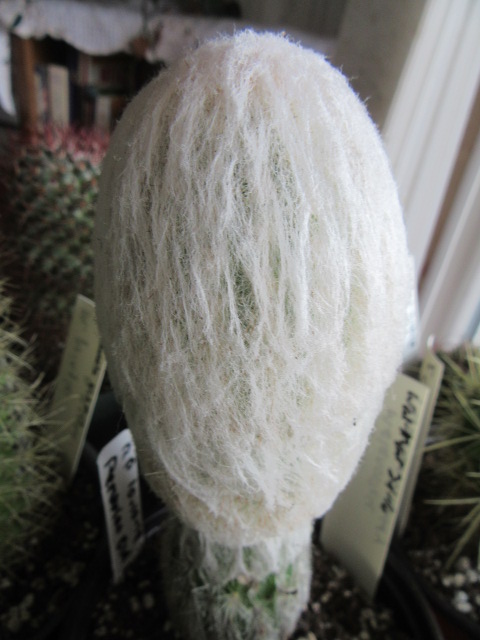
Espostoa melanostele subsp. nana close-up on 11-29-18, #534-14.
Under all that hair is a columnar cactus with numerous areoles with around 30 short radial spines each! While it may look soft to the touch, there are also many very thin central spines so you still need to handle them with care. If you noticed in the first photo, the upper of this cactus was like a little tuft of hair when I first brought it home
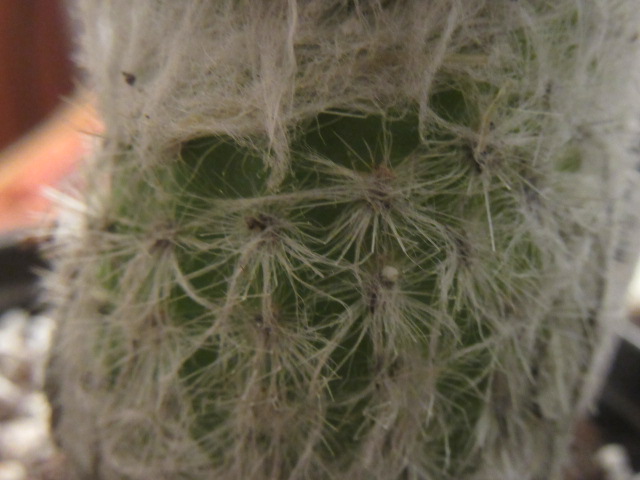
Espostoa melanostele subsp. nana close-up on 12-6-18, #537-1.
When I read the areoles of the Espostoa melanostele subsp. nana had that many spines I had to go get it and see for myself. I looked at the lower part of the cactus where there wasn’t as much hair. WOW!
<<<<2019>>>>

Espostoa melanostele subsp. nana (Peruvian Old Lady on 6-22-19, #593-15.
The cactus are back outside on the back porch for the summer.
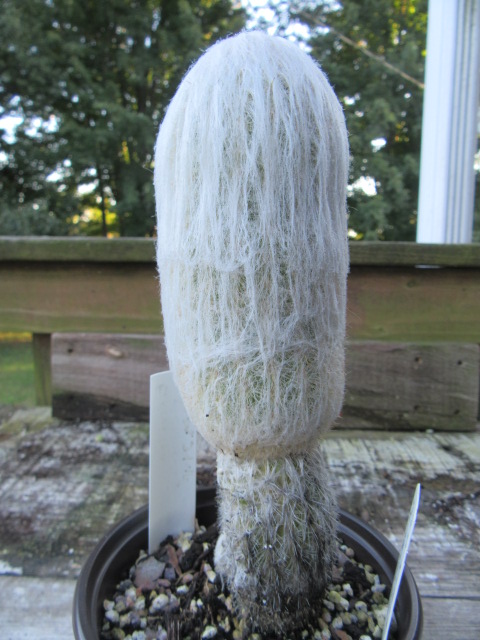
Espostoa melanostele subsp. nana (Peruvian Old Lady) at 7 1/4” tall x 2 3/8” wide on 10-11-19, #639-26.
The Espostoa melanostele subsp. nana made it through the summer just fine. On October 11 I had to move the plants inside because an “F” was in the forecast. As always, I took photos and measured the cactus before bringing them inside. The Espostoa melanostele subsp. nana measured 7 1/4″ tall x 2 3/8″ wide. That is an inch taller than last October and 1/4″ wider. That is very good considering it was 2 3/4” tall x 1 3/4” wide when I brought it home in February 2016.
<<<<2020>>>>

Espostoa melanostele subsp. nana (Peruvian Old Lady) at 9″ tall x 2 1/2″ wide on 10-15-20, #747-30.
I had to move the plants inside for the winter in 2020 on October 15 because an “F” was in the forecast. As always I photograph and measure the cactus and succulents as I bring them inside. The Espostoa melanostele subsp. nana measured 9″ tall x 2 1/2″ wide at the time. It’s amazing how much this cactus has grown since I brought it home in January 2016.

Espostoa melanostele subsp. nana on 10-15-20, #747-31.
The Peruvian Old Lady’s hair makes this cactus a very interesting companion.
<<<<2021>>>>
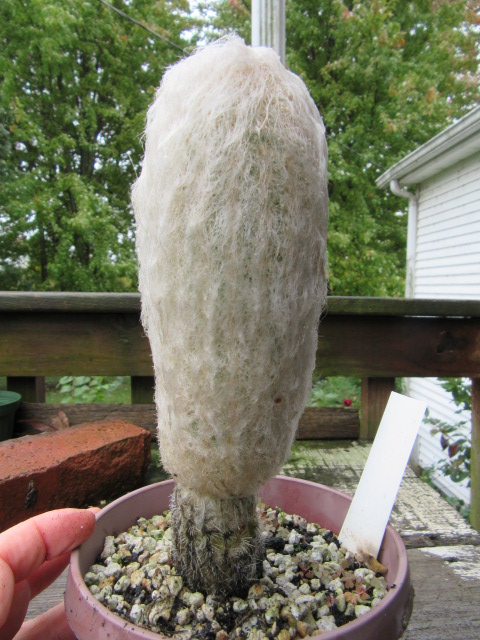
Espostoa melanostele subsp. nana (Peruvian Old Lady) at 8 1/2″ tall x 2 1/2″ wide on 10-28-21, #853-7.
Warm temps lasted a while longer in 2021 so I didn’t have to bring the potted plants inside until October 28. The Espostoa melanostele subsp. nana seems to have shrunk 1/2″ to 8 1/2″ and is still 2 1/2″ wide. Well, that’s OK since it seems perfectly happy and healthy. I figured with all the rain we had before I moved the plants in it may have grown more…
<<<<2022>>>>

Espostoa melanostele subsp. nana (Peruvian Old Lady) at 9″ tall on 10-16-22, #919-10.
Well, once again it was time to bring the potted plants inside for the winter on October 16 in 2022. I kept the cactus on the front porch in 2022 where they received more shade. They did fine there and The Espostoa melanostele subsp. nana grew to 9″ tall. She is a great cacti, but also a leaner and has to be straightened up off and on. If not, she will fall over… I am sure this cactus would have grown more if I weren’t a neglectful parent. 🙂
Espostoa melanostele produces white flowers in late spring through early summer and edible fruit about the size of a grape.
Wikipedia says, “Horticultural collection and the fact that the plant is slow-growing contribute to the fact that the plant is endangered.” Other sources say it is widespread in Peru and can grow up to 7” per year if properly fed and watered during the growing period. Ummm, that’s pretty darn good for a cactus! The IUCN Red List does not list them as a threatened species let alone endangered.
They grow their best when acclimated to full sun. If you grow your Espostoa melanostele inside over the winter, you will need to gradually introduce it to more sun.
Espostoa melanostele offsets readily and needs a lot of space to grow… Hmmm. Wonder when this happens? They can branch out from the base when about 30-36” tall. Let me see… At 7” per year that means it will take at least 4 years before it “may” branch out. GEEZ! I have had mine since 2016… Like I said previously, I am a neglectful parent. It would likely be taller if it were watered more during the summer.
Llifle says this cactus does better with a little more water than most cactus. Water thoroughly but allow the soil to dry between waterings.
<<<<2023>>>>
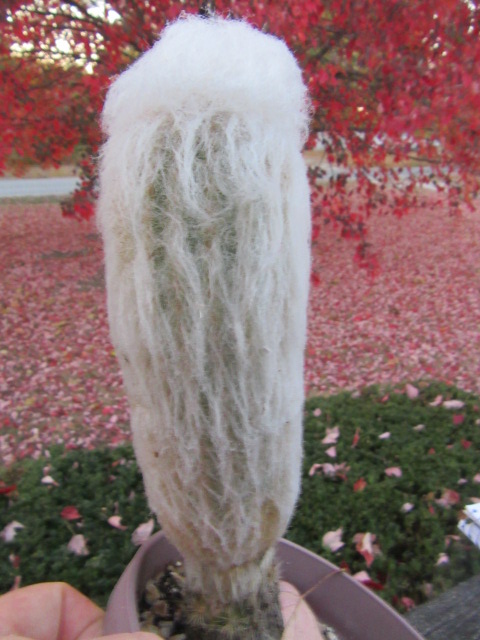
Espostoa melanostele subsp. nana (Peruvian Old Lady) at 9″ 1/2″ tall on 10-23-23, #967-10.
Even though there was no “F” in the forecast until October 30, it was going to be a rainy week so I moved the potted plants inside on the 23rd and 24th. Time for photos and measurements…
The Espostoa melanostele subsp. nana did very well during the summer on the front porch despite the heat and drought. It measured 9 1/2” tall when I moved it inside for the winter. It needs re-potted AGAIN because it was leaning AGAIN…
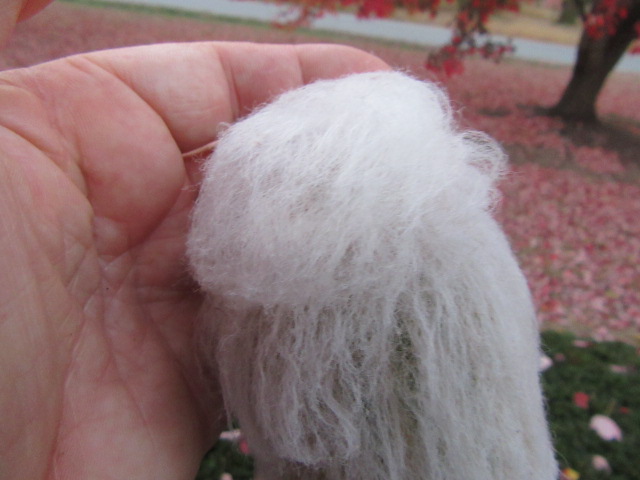
Espostoa melanostele subsp. nana (Peruvian Old Lady) on 10-23-24, #967-11.
I think she has been to the beauty shop…

Espostoa melanostele subsp. nana (Peruvian Old Lady) on 10-23-24, #967-12.
I will continue adding more photos and information as time goes by.
I hope you found this age useful. I would like to hear from you if you have any comments, questions, or suggestions. Please click on “Like” below if you have read this page. It helps us bloggers stay motivated. 🙂 You can click on the links below for further information. Links will take you directly to the information about this plant. Some photographs show plants that have more hair than others…